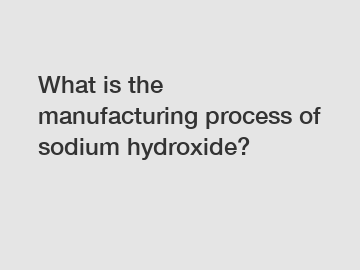What is the manufacturing process of sodium hydroxide?
Nengqian are exported all over the world and different industries with quality first. Our belief is to provide our customers with more and better high value-added products. Let's create a better future together.
Sodium hydroxide, also known as caustic soda, is a crucial industrial chemical used in the production of various products, including paper, textiles, soaps, and detergents, among others. It is also used in water treatment and food processing. The manufacturing process of sodium hydroxide involves several steps that require careful monitoring and control to ensure the quality of the final product.
## Electrolysis of Salt Water.

The primary method for manufacturing sodium hydroxide is through the electrolysis of saltwater (brine) in a process known as the chlor-alkali process. This process involves passing an electric current through a solution of sodium chloride (salt) and water to produce sodium hydroxide, chlorine gas, and hydrogen gas.
## Production of Chlorine Gas.
During electrolysis, the positively charged sodium ions migrate towards the cathode, while the negatively charged chloride ions migrate towards the anode. At the cathode, water molecules are reduced to produce hydrogen gas, while at the anode, chloride ions are oxidized to produce chlorine gas. Chlorine gas is collected and used for various industrial applications, such as disinfecting drinking water and manufacturing PVC.
## Formation of Sodium Hydroxide.
As the electrolysis process continues, sodium ions (Na+) are attracted to the cathode, where they react with hydroxide ions (OH-) produced from the water molecules. This reaction forms sodium hydroxide (NaOH), which is collected as a concentrated solution. The concentration of sodium hydroxide can be adjusted by controlling the current and the temperature of the electrolysis process.
## Purification and Concentration.
The sodium hydroxide solution produced from the electrolysis process may contain impurities that need to be removed to meet industry standards. Common impurities include excess salt, chloride ions, and other contaminants. The solution is typically purified through processes such as filtration, ion exchange, and chemical precipitation to remove impurities and improve the quality of the sodium hydroxide.
## Evaporation and Solidification.
Once the sodium hydroxide solution is purified, it is typically concentrated by evaporation to increase the NaOH content. Evaporation involves heating the solution to remove water and increase the concentration of sodium hydroxide. The concentrated solution is then cooled and crystallized to form solid sodium hydroxide, which can be further processed into flakes, pellets, or other forms for storage and transportation.
## Conclusion.
The manufacturing process of sodium hydroxide is a complex and energy-intensive process that requires careful control of various parameters to ensure the production of high-quality caustic soda. From the electrolysis of saltwater to the purification and concentration of sodium hydroxide, each step plays a crucial role in the overall process. The final product is a versatile chemical with numerous industrial applications, making it an essential ingredient in various manufacturing industries.
In conclusion, the manufacturing process of sodium hydroxide is vital for producing this essential chemical used in a wide range of industries. If you have any questions or need more information about sodium hydroxide production, feel free to contact us.
Are you interested in learning more about pharmaceutical chemicals suppliers? Contact us today to secure an expert consultation!

Comments
0